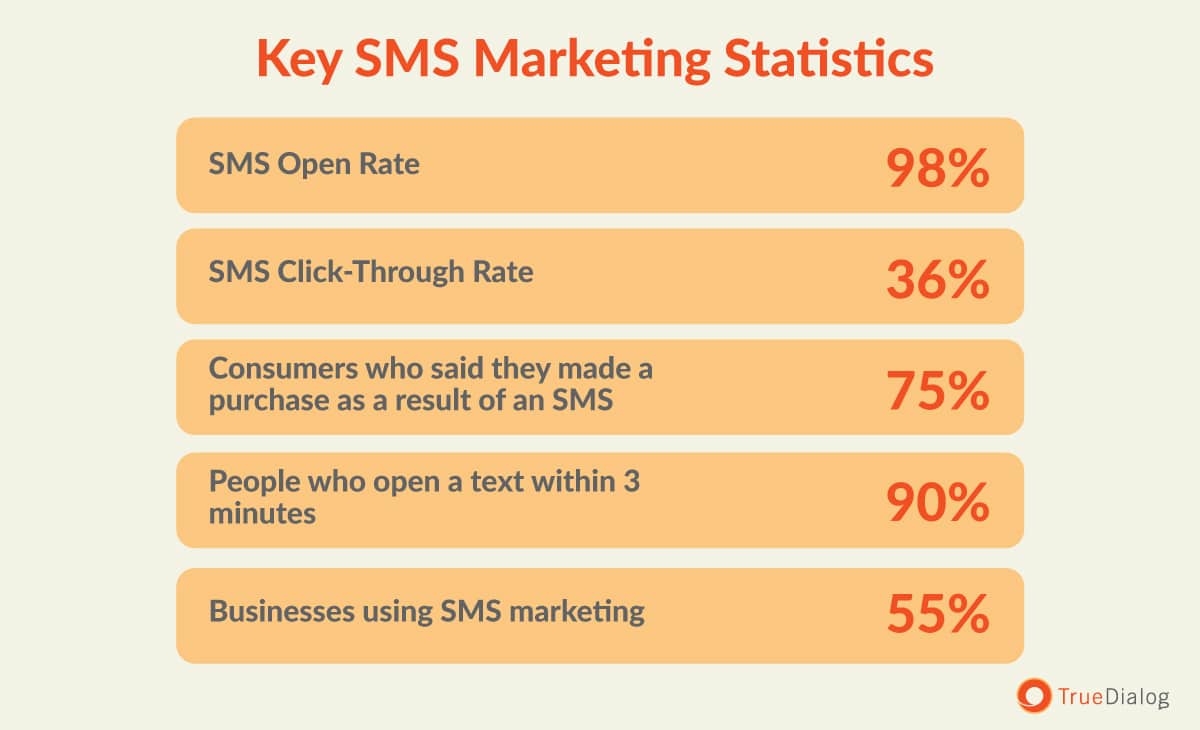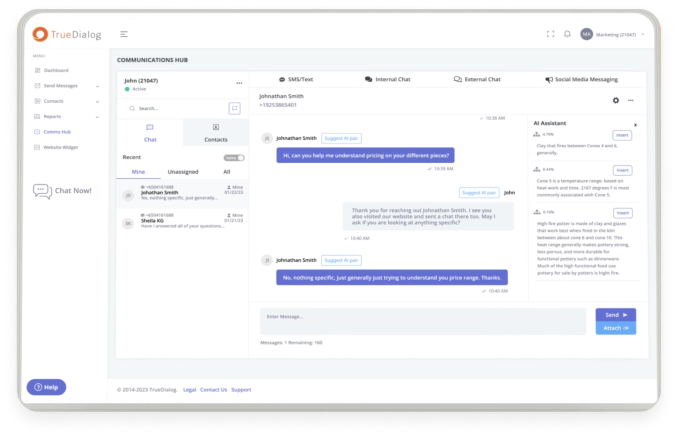There’s one simple reason SMS marketing is growing so rapidly: it works really well.
According to data from Pew Research, a whopping 98% of Americans own a cell phone — and, for most of us, these devices are rarely out of reach. We can’t help but dive for our mobiles when we hear the tell-tale chime signaling a new message (and, inexplicably, even when we don’t). In fact, we check our text inboxes hundreds of times each day — more frequently than email or social media — making it an excellent place for brands to stand out from the noise and connect directly with their audience.
At this point, the organizations that aren’t leveraging the power of SMS marketing are giving up an incredible opportunity — and likely yielding a hefty share of their market to competitors who’ve already jumped aboard.
Of course, you don’t have to take our word for it. If you’re still on the fence (or need a little help convincing senior decision makers that promotional texting is worth the budget), this collection of SMS marketing statistics should give you the insight you need.
But first, here’s a little background on why SMS is such an incredible marketing channel:
Why SMS Marketing Remains Powerful in 2025
On December 3, 1992, British test engineer Neil Papworth sent the world’s first SMS message (a short and sweet “Merry Christmas” to his colleague) and unknowingly kick-started a communication revolution. This two-word greeting became the first of trillions of SMS messages sent and received in the coming decades, transforming how we connect, share information, and keep in touch.
Today, texting is second nature. It’s woven into the fabric of our daily lives — our default channel for interacting with friends, family, colleagues, and classmates. For brands, it offers a mother lode of potential. Unlike email inboxes (where communications quickly become buried in a vast sea of unread messages) or social media platforms (where your brand is at the mercy of ever-changing algorithms), SMS offers modern marketers a high-engagement, two-way communication channel where messages are practically impossible to miss.
In 2025, when it’s more challenging than ever to cut through the noise and grab your audience’s attention, having this direct line to your prospects and buyers can provide a rare competitive advantage. And, as other marketing channels become more saturated, expensive, and harder to navigate, mastering SMS will soon become essential.
Key SMS Marketing Statistics You Need to Know
Take a quick look around any public space, and you’ll notice no one is far from their favorite mobile device. We keep our phones on our desks, dinner tables, and nightstands. We use them to occupy ourselves in waiting rooms and on public transit, and sneak furtive glances at our notifications in the middle of movies, meetings, and date nights. So, it shouldn’t surprise you that SMS texts boast sky-high engagement.
Here are a few SMS marketing stats to prove it:
-
SMS Open Rates and Engagement Stats
SMS has an astonishing 98% open rate (which means nearly all texts are eventually opened). This can be especially shocking to anyone who has ever managed an email campaign — a channel that rarely sees an average open rate over 25%, according to Omnisend.
-
Click-Through Rates and Conversion Rates
People don’t just open their texts, though. They interact with them too. Links within SMS texts earn an average click-through rate (CTR) of about 36%, according to MessageDesk — meaning more than one-third of recipients tap the link. And most industries see average conversion rates between 20 and 30%, according to SimpleTexting.
But how do texts translate into cold, hard revenue? According to SMS marketing data shared by Martech, a staggering 75% of consumers said they made a purchase as a result of an SMS from a brand.
Of course, this trend is less surprising when you learn that more than two-thirds of consumers (68%) said they only agree to receive messages from companies they plan to buy from. In other words, the contacts who opt in to your SMS marketing may be your most loyal and engaged customers, and strategic texts can become one of your most reliable revenue drivers.
Moreover, SMS messages can also slash a customer’s purchasing timeline. According to a survey by Klaviyo, 65% of people who purchased from an SMS text bought something they’d planned to buy in the future, but the promotional message sped up their decision. (And 14% of respondents who made a purchase hadn’t been in the market at all.) -
Response Times Compared to Email
But what about responses? How do SMS messages compare to email or other popular channels? According to data shared by SlickText, 90% of people open a text within three minutes, and Text-Em-All reports that the average response rate is a mind-blowing 45% (compared to just 10% for email).
Consumer Behavior and Texting Trends
You already know that most people are attached to their phones, and that texting has become the default digital communication mode. But to truly understand the power of SMS marketing, it’s helpful to consider how consumers use their phones to engage with brands — or, more specifically, how they prefer that brands engage with them.
-
How Consumers Prefer to Receive Information
When asked how they’d like to receive promotional content, three-fourths (75%) of consumers chose SMS over other marketing methods, according to data shared by Emarsys. And 91% of consumers said they’d opt in to SMS communications from a brand if it improved their experience.
(That said, 23% noted they’d ditch a brand for spamming them with excessive marketing messages, so remember that engaging with contacts via SMS is a privilege, and abusing this liberty will have an adverse impact.) -
Demographics and Mobile Usage Insights
While we might consider texting an activity for young people, it has increasingly become more popular across generations.
According to data from AARP, 73% of people 50 and older text daily (up from 61% in 2021). And Pew Research found that 94% of people 65+ own a cellphone (79% of which are smartphones). Furthermore, data shared by Attentive shows baby boomers engage more with branded text messages than any other age group.
Of course, younger generations aren’t far behind. And given that nearly all children in the U.S. have a cell phone by age 15, according to ConsumerAffairs, it’s unlikely that mobile engagement with brands will slow anytime soon. In fact, by 2027, purchases completed via mobile phones are expected to reach $856 billion.
Looking at mobile phone adoption by education and income bracket, published by Pew Research, also demonstrates high usage rates across the board. While the data shows smartphone ownership is highest among college-educated adults (97%), it’s still prevalent at all levels of education, and 83% of people with a high school diploma or less also own a smartphone.
Additionally, smartphones (and cell phones in general) have become more affordable over the past couple of decades, making the technology more accessible across income levels. Today, 79% of people with an annual household income below $30k own a smartphone, as do 90% of people reporting a household income between $30k and $69,999.
Business Adoption and ROI Statistics
From engagement rates to mobile usage, there’s no shortage of data illustrating the business potential of SMS. But if you’re still unconvinced, consider that SMS marketing adoption has skyrocketed in recent years. In other words, there’s a good chance your competitors are already using it.
For example, SimpleTexting compared a few text marketing stats and discovered that business use of SMS marketing software rose 45% in two years. (In 2022, 55% of businesses were using SMS marketing. In 2024, that number jumped to 80%.)
Here’s a breakdown by industry use, plus ROI benchmarks that prove SMS is worth the investment:
-
Industries Leading in SMS Marketing
A SimpleTexting survey found that customers are most likely to opt in to texts from e-commerce and retail brands (48%), followed by healthcare (36%), finance (24%), and consumer services (23%). But that doesn’t mean there isn’t incredible potential in other verticals and sectors.
While the B2B space has historically hesitated to leverage SMS marketing at the same rate as B2C brands, the tides are shifting. About 90% of business leads say they’d prefer to be contacted by text rather than a phone call, according to Selling Power. And given how challenging it’s become to reach B2B audiences via email and social platforms, SMS marketing may be just what your brand needs to connect with your contacts and move the needle.
-
ROI Benchmarks for Text Campaigns
One of the first questions most senior decision makers ask when evaluating a potential marketing investment is, “What’s the ROI?” In this case, it’s pretty substantial.
According to G2, for every $1 spent on SMS marketing, brands earn an average of $71 in revenue ( which calculates to a return of 7000%). Compare this to email, which has an ROI of $36 for every dollar spent, according to Litmus — or social media marketing, which yields a 200% return (or $3 return for every dollar spent), according to data shared by SEO.com, and it’s clear why SMS belongs in your marketing arsenal.
Of course, SMS marketing ROI varies depending on several factors, including which mass texting service you choose and whether it has the features to support your campaign needs. That’s why it’s important you consider your options carefully and choose a solution proven to drive success in your industry.
Future of SMS Marketing: Trends and Predictions
In the three decades since that first fateful SMS holiday greeting reached its recipient, we’ve seen the evolution of emojis, the progression from T9 to QWERTY keyboards, and the rise of multimedia messaging. Most recently, we’ve seen an uptick in devices and carriers supporting rich communication services (RCS) — a next-generation messaging protocol designed to accompany SMS. In late 2024, Apple released RCS for Messenger with its iOS18 update, further boosting its adoption and underscoring its potential to change how we communicate via text.
As technology advances and new texting trends surface, we’ll likely see much more.
-
AI, Personalization, and Automation in SMS
Machine learning (ML) is advancing at a meteoric pace. In less than a decade, it’s dramatically changed marketing by helping us automate rote tasks, analyze giant sets of behavioral data, streamline content creation, and achieve personalization at scale. Time will tell what the future has in store, but we predict AI will only become more essential, and those who learn to master AI-powered tools now will be more likely to leapfrog their competition in the years to come.
When it comes to SMS marketing, that means choosing a platform with AI-enabled features and advanced automation. For example, TrueDialog’s TrueDelivery uses AI to boost users’ SMS deliverability by ensuring carriers don’t inadvertently flag messages as spam. The tool assesses message content (based on carriers’ spam filter triggers) and gives marketers a deliverability score before sending their texts. This way, teams can edit messages to avoid spammy-looking content and increase deliverability rates.
Marketers can also use AI to generate a vast library of SMS responses and personalize message content — which, according to Klaviyo, can increase a contact’s likelihood of subscribing to SMS by 33%.
Additionally, it’s helpful to choose an SMS marketing provider with a robust SMS API. This will help you automate campaign workflows for better team efficiency, integrate the platform more easily with other marketing and sales tools, and deploy dynamic messaging to boost contact engagement. -
Regulatory Changes and Privacy Concerns
As SMS marketing has grown, so have regulations governing marketing communications, consumer privacy, and data use.
The Telephone Consumer Protection Act (TCPA), which protects consumers from unwanted solicitations by phone, has issued several requirements over the past few years. For example, businesses must obtain explicit consent from consumers before texting them, offer easy paths to opt out, avoid texting contacts between 9 p.m. and 8 a.m. (also known as “quiet hours”), clearly identify themselves in messages, provide a clear privacy policy, and take measures to protect recipients’ data.
Given the hefty fees and risk of becoming blocklisted for non-compliance, it’s important for businesses to follow requirements outlined by the TCPA — as well as the CAN-SPAM Act, the General Data Protection Regulation (GDPR), and any other relevant local, federal, or international laws
With security breaches and data theft on the rise, we expect to see stronger regulations in the coming years, especially when marketing to audiences outside of the U.S.
Additionally, organizations committing to scaling engagement with mass texting should consider registering for 10-digit long code (10DLC) and short code numbers. These codes are vetted and pre-approved by carriers for promotional texts, meaning messages from these numbers are less likely to be flagged as spam and ensure better deliverability.
Final Thoughts: Leveraging SMS Statistics and the Growing Power of SMS Marketing
Keeping up with the latest texting statistics and SMS marketing research is helpful when making the case for SMS marketing at your organization, and can help you and your team set realistic benchmarks for your text campaigns. But, moreover, these stats underscore the growing value of texting as a method for quickly reaching, engaging, and converting your buyers.
As a marketer, you know there’s nothing more powerful than building strong, meaningful connections with your audience – and having a reliable one-on-one channel is essential for growing and maintaining those connections. By adding SMS marketing to your toolbox, you can strengthen your multi-channel campaigns, get your message directly in front of your warmest leads, and drive measurable results.






